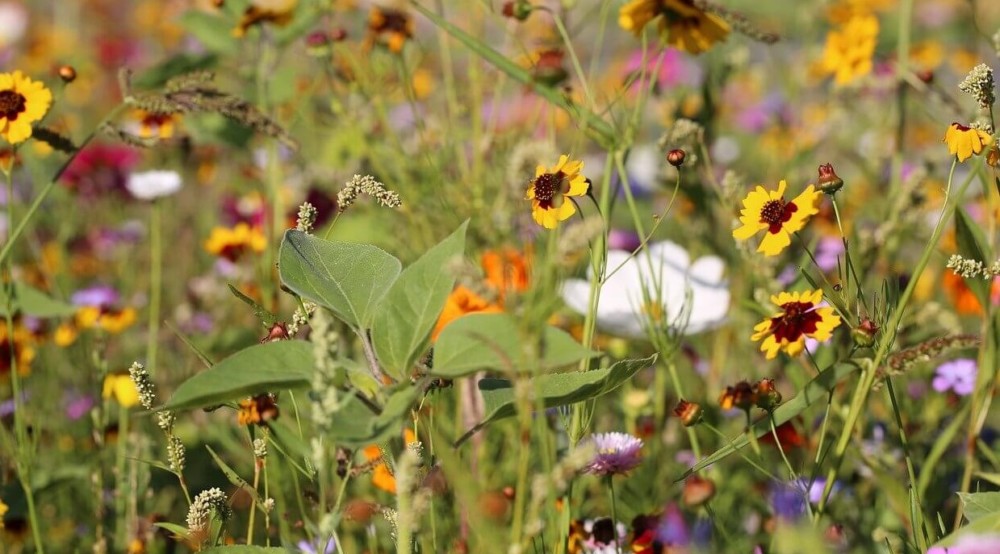Bees are essential to gardening, food production and farms. Although many people don’t realize it, bees are also essential to our way of life because so much of the food we eat depends on pollination by bees.
If you want to make an environmental difference, then a very important action you can take is to plant some flowers that will help your local bees. In suburban, urban and rural areas, bees are struggling to find enough food that won’t kill them.
Cities, grass, and neighborhoods have taken over natural plants that bees rely on for food. Farming has used pesticides that are killing bee colonies. As a result, bees face huge hurdles to survival and are facing Colony Collapse Disorder.
Bees are dying at alarming rates.
Whether you can plant a bee garden, or just cultivate a few potted plants on your window or porch, even small efforts can make a big difference locally. Don’t forget to check out our full guide on how to be bee-friendly.
How to plant a bee garden and best help bees:
- Plant Flowers That Bloom During Different Seasons
- Use A Variety Of Plants That Accommodate Various Bee Tongues
- Plant Flowers That Are Blue, Purple, Yellow, and Orange Colored
- Cultivate Native Plants
Simple steps that make a big difference. This article covers over 100 various plants whose flowers provide food for bees. You’ll also know how to recognize and choose blooms that are more likely to attract bees in your area.
1. Plant Bee-Friendly Flowers and Plants For Every Season:
No matter where you live, some plants are helpful for bees all year round. It’s important to accommodate many types of bees to help foster healthy biodiversity in your area. Even in the city, small spaces of bee-friendly flowers can make a huge difference.
During the winter, it’s important to provide bee-friendly plants as well. Some bees hibernate, but others stay active all winter long. Bee-friendly plants provide habitats for bees and food that keep their energy up.
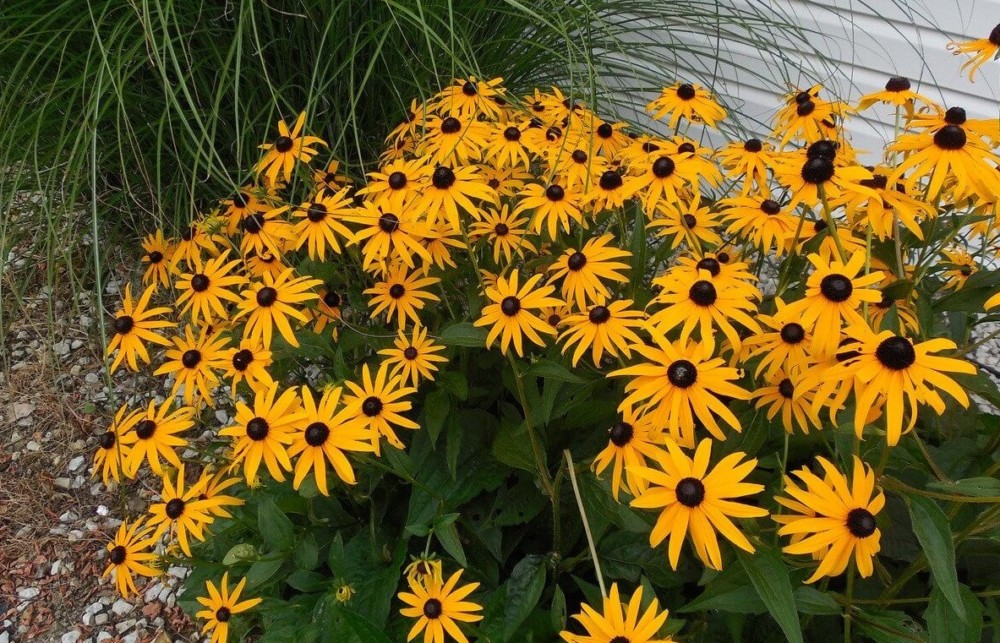
Check out these flowers that are helpful food for bees during all four seasons:
| Early Spring | Summer | Late Summer & Fall | Winter |
| Alliums | Agastache | Actaea simplex | Borage |
| Annual Honesty | Alyssum | American Beauty Berry | Clematis cirrhosa |
| Bluebells | Bee Balm | Anemone or Windflower | Heather |
| Berry Plants | Bergamot | Asters | Crocuses |
| Bugle Herb (a type of mint) | Butterfly bush | Basil | Hellebores |
| Christmas / Lenten Rose | Cardoon | Black-Eyed Susans | Ivy |
| Columbine | Chives | Bluebeard or Blue Mist | Mahonia |
| Cranberry | Clover | Borage or Bee Bush | Oregon Grape |
| Crocus | Cranesbill | Broccoli | Primrose |
| Daffodils | Comfrey | Bush Clover | Snowdrops |
| Flowering Currant | Echinops | Calendula | Rosemary |
| Foxglove | Erysimum Bowles | Colchicum | Sarcococca |
| Fruit Trees | Hyssop | Coneflower | Oregon Grape |
| Grape | Goldenrod | Cornflower | Snowdrops |
| Hawthorn | Geranium | Cosmos | Winter Aconite |
| Hazelnut | Lavender | Dahlia (Single flower) | Winter Heathers |
| Heather | Marigolds | Goldenrod | Winter Honeysuckle |
| Heliotrope | Mauve | Japanese Anemone | Yarrow |
| Hyacinth | Milkweed (also important for Monarch butterflies) |
Joe Pye Weed | |
| Japanese Mahonia | Mint | Lemon Balm | |
| Lilacs | Peony | Liatris | |
| Marigold Calendula | Penstemon | Mint | |
| Primrose | Phlox | Nasturtium | |
| Pansies | Poppies | Oregano | |
| Pulmonaria | Salvia | Pansies | |
| Pussy Willow | Scabious | Pumpkin | |
| Rhododendron | Shasta daisies | Sage | |
| Sea thrift | Snap Dragons | Salvia | |
| Siberian Squill | Sunflowers | Sedum or Stonecrop | |
| Snowdrops | Vegetable Plants | Squash | |
| Spurges | Vervain | Stonecrop | |
| Viburnum | Zinnias | Thyme | |
| Wall Flowers | Verberg bonariensis | ||
| Willow | White Snakeroot |

2. Use A Variety Of Plants That Accommodate Various Bee Tongues
Bees have either a long tongue or a short tongue. Both tongue types are specifically adapted for certain flowers. Often the flowers and the bees have evolved together and so it’s important to plant local varieties and species of flowers.
Some long-tongued bees include Honey bees, bumblebees, carpenter bees, digger bees, and leaf-cutting bees.
Long-tongued bees are suited for longer flowers that carry pollen deeper in the flower.
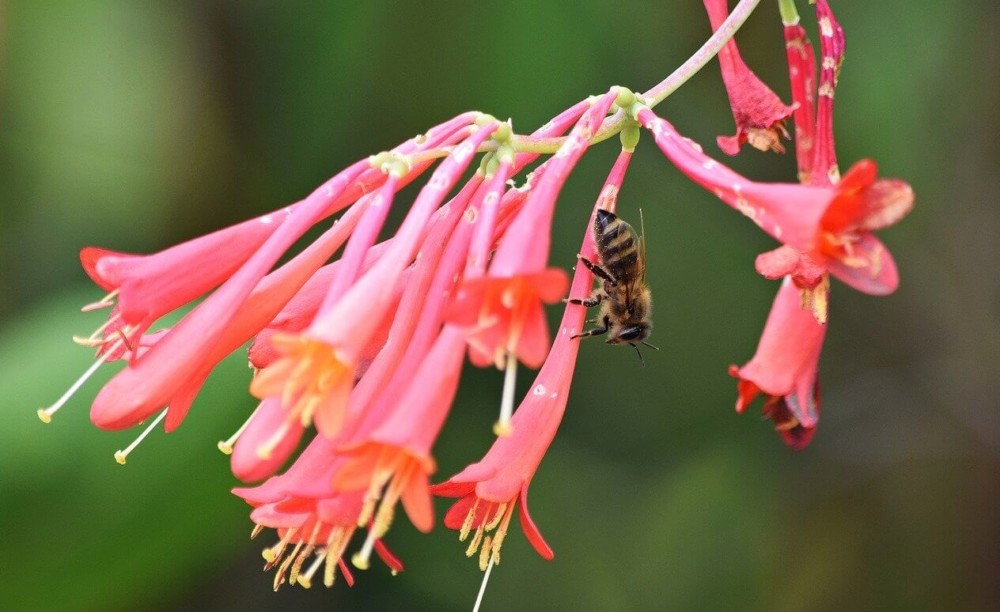
Short tongued bees include Andrenid bees, smaller miner bees, plasterer bees, masked or yellow-faced bees, and sweat bees.
Short tongued bees need more open flowers and where the pollen is easily accessible.
Plants For Long and Short Tongued Bees
| Long Tongued Bee Flowers | Short Tongued Bee Flowers |
| Columbine – Bumble Bees – Spring | Columbine – Sweat Bees – Spring |
| Great Blue Lobelia – Some of both – Late Spring | Great Blue Lobelia – Some of both – Late Spring |
| Wild Lupine – Some of both – Late Spring | Lead Plant – Both – Early Summer |
| White Wild Indigo – Bumble Bees – Late Spring | |
| Lead Plant – Both – Early Summer | Lead Plant – Both – Early Summer |
| Milkweed – Both – Midsummer | Milkweed – Both – Midsummer |
| Wild Bergamot – Both – Midsummer to early fall | Wild Bergamot – Both – Midsummer to early fall |
| Butterfly Weed – Both – Late Summer | Butterfly Weed – Both – Late Summer |
| Partridge Pea – Some of both – Summer to fall | Partridge Pea – Some of both – Summer to fall |
| Lesser Calamint – Bumble Bees – Summer & Fall | |
| Coneflower – Both – Summer to fall | Coneflower – Both – Summer to fall |
| Hardy Ageratum – Both – Summer to fall | Hardy Ageratum – Both – Summer to fall |
| Goldenrod – Both – Late Summer and Fall | Goldenrod – Both – Late summer to Fall |
| Joe Pye Weed – Both – Midsummer – Early Fall | Joe Pye Weed – Both – Midsummer – Early Fall |
| Yellow Giant Hyssop – Both – Summer to early fall | Yellow Giant Hyssop – Both – Summer to early fall |
| White Snakeroot – Both – Fall to frost | White Snakeroot – Both – Fall to frost |
3. Plant Flowers That Are Blue, Purple, Yellow, and Orange Colored
Bees have a wide color vision that focuses on flowers in the blue and purple range as well as yellows and oranges. Red flowers become dark to them and don’t attract bees as much as other colors.
Plant a variety of colors in your yard and flower gardens. Groups like colors together so it’s easier for bees to locate from a distance.
Did you know?
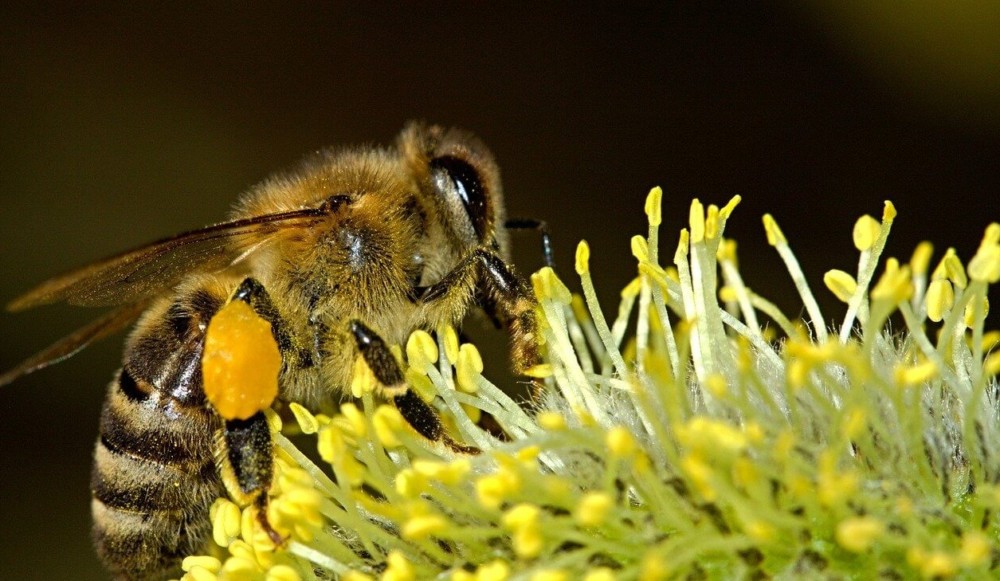
Many species of bees fly 2-3 miles every day. So, it’s important to make the flowers visible to bees flying above your property. Even if you don’t have a lot of space, try to cluster similarly colored flowers together.
If you want to go one step further to helping bees, you can also make sure to plant a variety of flower shapes and heights. It makes it more visually appealing and helps to provide various shelters and habitats for bees, in addition to providing food for them.
4. Cultivate Native Plants
It’s important to plant native plants that encourage and help out native bee species. The vast majority of native bee species in North America are under threat or near extinction. One of the best ways to help these struggling helpers is to plant native flowers.
This helps native populations to flourish. Some bee species are invasive and affect local bee populations. Specifically, one major issue is the African bee, which is aggressive to people and bees alike. These larger bees are killing local colonies and mating with the queen bee, which makes native bees more aggressive.
When you plant native plants, you help to encourage and protect native species. If you start a beehive, then make sure that you purchase a queen bee that is certified as a pure honeybee so that your hive won’t be aggressive.
The USDA has a great resource for finding out which plants are native to your state and North America. You can find the local plant guide here. You can search for plants by their common name, scientific name, or symbol. Plus, there’s a lot of other resources.
Another benefit of planting native flowers is that you will get plants that are hardy to your zone. The hardiness zone of a plant tells basically what climates a plant can thrive in. Some plants do well in cold winters and cooler summers, while other plants need warmer winters and hot summers.
You can check out your hardiness zone at USDA
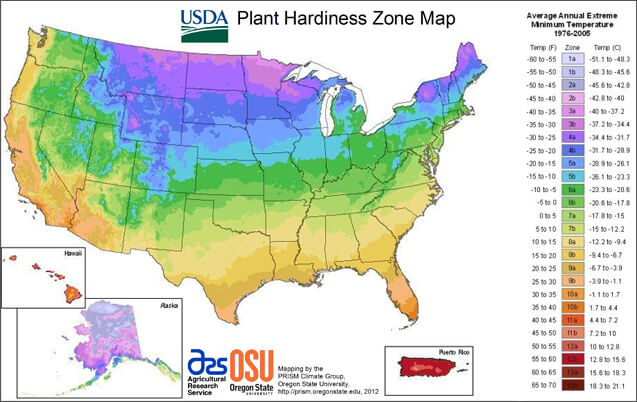
Frequently Asked Questions
This seems so complicated, how can I get started? Helping bees out is as simple as choosing a couple of flowering plants to grow outside. You can get started in pots, in a small area, or simply let an area go back to the wild with traditional “weed” native plants. Even a small effort will make a big difference!
Do all bees sting? Not all bees can sting or have a stinger. Only female bees have a stinger and not every species of bees even has a stinger. Bees are not interested in stinging people unless they feel threatened. This usually happens when they think the hive is threatened or occasionally if the individual bee feels threatened.
What bees can sting? Honey bees, carpenter, mason, sweat, and bumblebees are a few of the varieties of bees that can sting. Of those species, carpenter bees are usually the most aggressive in defending their hive. Bees can remember individual faces so if you threaten a hive and return, they are likely to remember you and be more threatening from the onset.
What bees don’t sting? Male bees do not have a stinger and do not sting. Their only purpose is to mate with the queen, which causes their death. Solitary bees will not sting because they have no hive or young to protect. There are over 200 species of solitary bee species and most are endangered because of habitat loss. Bumblebees can sting, but will only sting after they have taken a defensive pose to warn you off. If the threat continues, they will sting.
Can plants self pollinate if bees die off? Some varieties of trees and plants have been bred to be more self-pollinating than heritage varieties. However, even “self-pollinating” plants produce better when pollination from other plants occur. Plus, many types of food still require pollination and for which there are not self-pollinating varieties. These foods will be lost if bees die out.
Related Articles
You might also find these related bee articles helpful.
Grow Allergy-free Flowers that Also Help Bees
The importance of Bees: Foods that Require Bees

